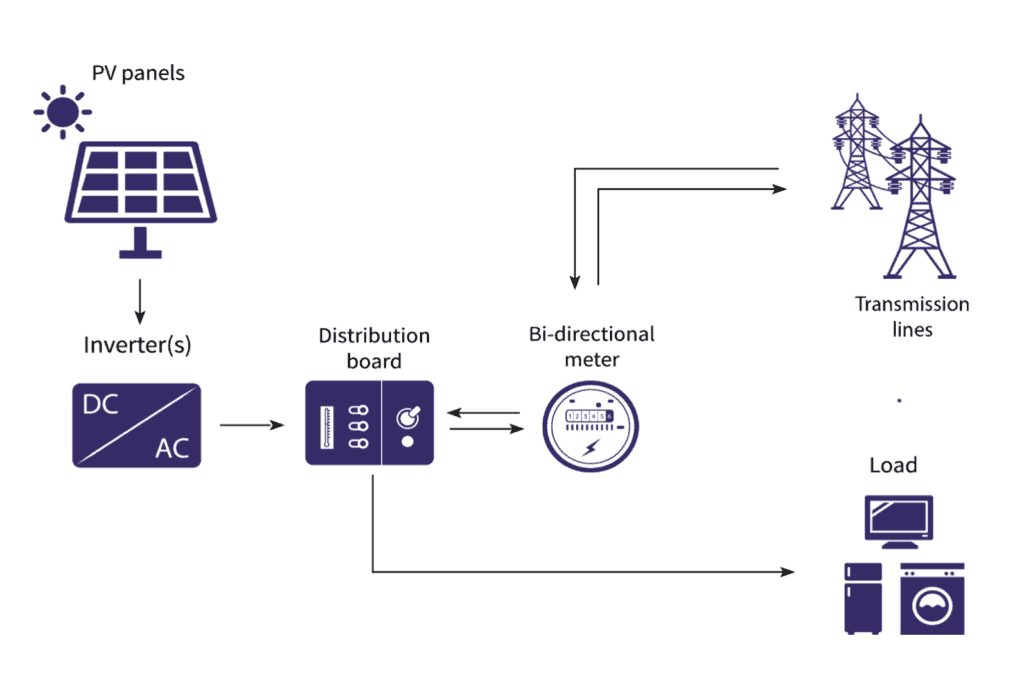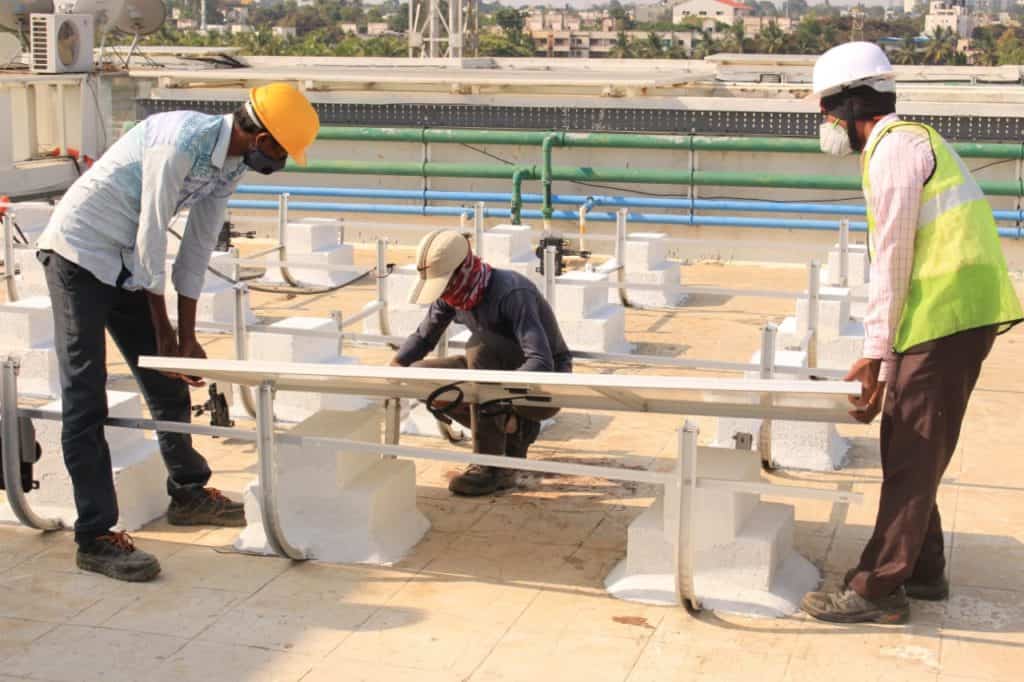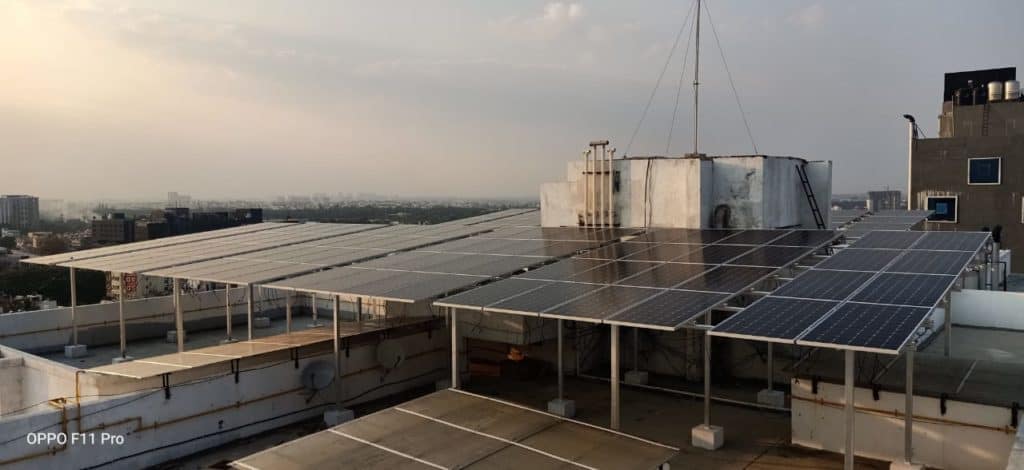As we saw in Part 1 of this series, many apartments in Bengaluru have been rushing to install rooftop solar panels in view of expected policy changes. These systems have helped apartments steeply reduce their monthly power bills for common areas.
Here’s a guide on how you can get a rooftop solar system installed in your apartment too, based on information from the Bangalore Apartments’ Federation (BAF), a collective of nearly 500 apartment associations in the city.
Also see: A guide to installing solar power in your home
What is a rooftop solar system?
In this system, solar panels are fitted on the roof of your apartment. These panels generate electricity, which can be immediately used to power the apartment’s common areas or exported to BESCOM’s grid.

Why install this system at all?
There are several advantages of installing a rooftop solar system – not just economic but also environmental. Here are a few:
- Rooftop solar system enables huge cost savings. General experiences of apartments that installed these, suggests monthly savings of almost Rs 1000 per kWp installed. (kWp is kilowatts peak – power generated during peak performance).
- A 100 kWp solar plant is equivalent to planting at least two new Lal Baghs in the city, as it can avoid 80 tonnes of carbon emissions per year. A 5 KWp solar system is the same as planting 2500 trees or not driving 4,56,000 km.
- The source of energy is free and infinite.
- It is a clean source of energy, keeps the air clean, and ensures less coal is burned in thermal power plants to generate electricity.
- Solar panels are long lasting, with a life span of almost 25 years. They are easy to maintain and pose no safety concerns.
What is the benefit of setting up the system now?
Karnataka is one of the few states that has a policy on net metering. The policy has been due for change post March 31, 2020.
Moreover, on December 9, 2019, the Karnataka Electricity Regulatory Commission (KERC) rolled out a new policy allowing third-party investments on solar rooftop in non-residential buildings to be considered only under the gross-metering scheme. Experts and citizen groups now believe that soon KERC might allow only gross metering even for residential buildings.
In terms of Return on Investment (RoI), assuming that electricity tariffs from the grid remain at their current rates (which is highly unlikely), a solar plant will pay for itself within 10-12 years. If rates increase in the following years, savings can be significant enough to reduce this period to eight or even six years.
If you generate more than you consume, and thus have an active grid export system, the costs after return on investment (ROI) would be negative; i.e. you’d be paid for the electricity you produce.
Net Metering vs Gross Metering
In net metering, the apartment complex uses the generated solar power for its common area needs, exports excess power to the grid, and draws BESCOM power for any shortfall. In practice, apartments will have excess power in the day time, and will use BESCOM power at night.
BESCOM installs a bi-directional electricity meter in the complex, which measures both the power drawn as well as power exported. And the apartment complex only pays for the net amount consumed, i.e units consumed minus units exported. This helps avoid installing batteries which are expensive and have a short life, thus reducing costs.
With gross metering, the total energy generated by the solar rooftop plant is to be uploaded into the grid without being used directly by the consumer. BESCOM pays the plant owner as per the PPA (Power Purchase Agreement) tariff. The apartment consumes BESCOM power for its needs, and pays BESCOM the standard electricity rates.
Common technologies in rooftop solar
There are various technologies used in solar panels, like Mono Crystalline, Poly Crystalline and Thin Film solar panels. Monocrystalline solar panels have higher power efficiency rates and are also space-efficient.

There are different types of inverters too: String inverter, optimisers, micros and hybrid models. In the string inverter system, panels can be connected in a series to make a string, which is then connected to the inverter. In the micro inverter system, each panel can be connected to a single micro inverter/power optimiser. Micro Inverters are more expensive but have longer warranty, free system-level monitoring, and easier maintenance.
How much money can a rooftop solar plant save?
The cost of rooftop solar systems varies from apartment to apartment. The most important step for installing these systems is getting a technical feasibility study done by the vendor. The technical feasibility study will help you know how many panels are needed and of what kind, the type of inverter used, shadowing conditions and other technical specifications.
However, there’s one simple thumb rule – 10 square metres or 100 square feet of terrace space can be used to set up 1 kWp of solar capacity.
So, if an apartment complex has 7,500 square feet of free roof space with minimal shadows, a plant with 75 kWp capacity can be installed.
- Total cost of such a plant: Approximately Rs 50 lakh (depending on the technology)
- Generation of 1.05 lakh units in the first year (which reduces by 1% every year due to panel degradation)
- Net savings of approximately Rs 8.75 lakh per annum in electricity bills
- Payback period (time taken for the investment to be recovered) of about six years
- Project returns: 16-20% Internal Rate of Return (without subsidy)
Note:
- These are broad estimates based on current prices. Actuals will depend on many other factors such as shadowing, length of cables required, etc.
- The above IRR of 16 – 20% is at the prevailing BESCOM tariff today. If one takes into account hike in electricity tariffs, which usually varies in the range of 4-11%, the payback period is even shorter and the IRR can be higher than 20%.
BESCOM buys solar power at low rates, and hence net export of power reduces IRR. So, in general, it is better to set up a smaller plant than the sanctioned load, which would generate only as much power as is needed for the apartment’s own needs.
How to ensure investment for setting up the system?
The best way is to invest a part of the apartment corpus in setting up the system. If that’s not possible, residents should be encouraged to create a new corpus and contribute to it.

The other option is to take the help of specialised vendors known as Renewable Energy Service Companies (RESCOs). RESCOs will invest in setting up the system and sell the power under a Power Purchase Agreement (PPA). As per the PPA, all the investment is done by the RESCO but in return it guarantees a lower cost of power than what your association pays to BESCOM.
The Bengaluru Apartments Federation (BAF) does not recommend this model. A fully-owned system is far more beneficial for the apartment.
How to ensure your investment does not fail?
- A fair amount of research is needed to identify the right vendor and configuration for your apartment, as each apartment has different space availability, requirements, shadowing, etc.
- Always have long-term maintenance contracts with the vendor, over and above the free maintenance period which could vary between one and five years. Also, seek generation guarantees (guarantee for a particular amount of power generation from the panels) to the extent possible.
- Generally, solar panels demand only good maintenance, and no repairs. But if one of the panels does break, it would have to be replaced immediately since a panel comes as a single unit. Other parts of the system – wires, AC / DC distribution boxes, etc – are easily available in the market
Some known vendors include:
- Hyde Source & Green Energy Technologies
- Ecosoch
- Solar Square
- Renxsol Ecotech
- Insolare Energy Private Limited
- PlaySolar Systems Pvt Ltd
- Lakeforest Green Energy
Paperwork required for the installation
- Purchase and maintenance agreements with the vendor
- 25-year PPA with BESCOM, and some certifications
The vendor will take care of most of the BESCOM-related paperwork.
A CSTEP project -- CREST provides high-resolution aerial imagery to help choose the ideal location with least shadow and maximum radiation for your rooftop solar system. For more, see http://demo.cstep.in/crest
Note: Meera K contributed to this article.
With the increase of solar panel’s efficiency and peak power capacity in the recent models, the rooftop area required has come down to about half (5 sq.meter for a kiloWatt power). This itself gives an added incentive to go solar! The cost of such super solar panels has been falling recently!
Ours is a independent house with three floors, each floor has separate single phase meter. In addition we also have a three phase meter for common are which include lift – 3 hp 3 phase motor, bore, two sump pumps 1 hp each plus booster pump. Structure already exists that can accommodate 18 solar panels. We also have 1 kwa ups separate for each floor. We also have 450 watts small 3 panel solar system with 200 mha battery to power moon lighting and control panel of hydronic lift.
What is the best option if e need 2 kw solar net metering system for each floor separate. Total in all 6 kw.
Please contact the vendors listed in this article like EcoSoch Solar, Hyde source and they would be able to guide you better.
U have wrongly mentored resco Will invest as one option . Please it needs to be noted BESCOM won’tallow net metering under resco which involves PPA and sale of electricity, which is illegal as per dec 19 policy
Own investment is only way to do now
With Enough Panels can we run a 1.5 tonnes of Inverter AC with string inverter system
If so can I run the AC directly in day time from 8:00 am to 5:00pm
Also I’m having a Nexon EV Car can I get the car batteries charged from the rooftop panels & inverter
Can we install for domestic use? And what will be the cost?
Great article! Got some basic calculations to keep in mind before thinking for such project. Thankyou
We have installed a 5kva unit (net metering) on our penthouse terrace. The initial paper work was a bit difficult and being the first to install in an apartment society had its own challenges.
Bangalore climate we should be able to generate 500-600 units a month with a 5kva system
Hi
I have 150sft roof area available for solar panel installation. How much power can it generate?
My monthly BESCOM power utilization is 150 units.
We are interested for this our Apartment block 16 flats, accord your review, Jaipur Rajasthan
9462537767
We already have solar panels on our building terrace and working very effectively. I just want to understand is it possible to install solar panel on our window rain sheds which we install to stop rainwater to enter our rooms and if yes how much these can be cost effective.